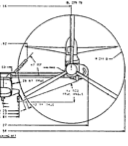Connecticut lawmakers are supporting bid protest to FLRAA contract
(Inside Defense, Jan. 6, Dan Schere)
Connecticut's congressional delegation is throwing its support behind Sikorsky and Boeing’s protest of the Future Long Range-Assault Aircraft contract, awarded to Textron's Bell last month. Sikorsky and Boeing’s DEFIANT X proposal was one of two competing finalists for the FLRAA contract, which will eventually replace the UH-60 Black Hawk helicopters starting in 2030. The other finalist was Bell’s V-280 Valor, that latter of which uses a tiltrotor design.
Sikorsky is based in Stratford, CT while Bell is based in Fort Worth, TX.
The Army announced on Dec. 5 that it had selected Bell’s proposal for the contract -- worth $232 million for the first 19 months, and up to $1.3 billion total. Army officials said at the time that the service took a “best value approach” in making its decision but gave few other specifics.
Lead contractor Sikorsky, owned by Lockheed Martin, and Boeing filed the protest with the Government Accountability Office on Dec. 28, stating “the data and discussions” led the companies to believe “the proposals were not consistently evaluated to deliver the best value in the interest of the Army, our Soldiers and American taxpayers.”
The same day the protest was filed, Sen. Richard Blumenthal (D-CT), a member of the Senate Armed Services Committee, wrote in a tweet that he would “work to assure immediate attention & favorable consideration of Sikorsky’s challenge.”
“Our nation deserves the best helicopters & Sikorsky’s world class work force can make them,” he wrote.
Additionally, all members of Connecticut’s congressional delegation released a statement on Dec. 29 saying they have yet to receive answers on how the Army made its decision on the FLRAA contract.
"We are hopeful that this protest action and the forthcoming process will shed light on the Army’s decision making, and that the highest level of fidelity is conducted throughout,” they wrote in the statement.
Karolina Wasiniewska, a spokeswoman in Blumenthal’s office, told Inside Defense Thursday that they don’t have any further comments at this time.
Rep. Ronny Jackson (R-TX), who represents the district in which Bell is located, called the Army’s decision in selecting the company “fantastic.” Casey Nelson, a spokeswoman for Jackson’s office, referred Inside Defense on Thursday to a statement Jackson gave to KVII, an Amarillo ABC affiliate, in which he said the “Army conducted a thorough process” making its FLRAA selection.
"I have been intimately involved with all things Future Vertical Lift during my time in Congress and, based on my deep understanding of the mission’s requirements, Bell’s V-280 is the right platform."
The $1.7 trillion omnibus package passed last month by Congress and signed by President Biden includes $698 million for research, development, testing and evaluation for FLRAA -- $5 million more than the Army put in its original request for fiscal year 2023.
Status of program uncertain
According to the Competition in Contracting Act, a program’s performance is automatically suspended when a bid protest is filed, GAO spokesman Chuck Young wrote in an email to Inside Defense on Tuesday. However, an agency can override the stay if “the agency determines that it would be in the best interest of the government,” he wrote.
When Inside Defense asked the Army whether a stay of the contract was in place, David Hylton, a spokesman for the service’s Program Executive Office for Aviation said “due to ongoing litigation,” the office is “unable to discuss or provide additional details relative to the FLRAA program.”
Bell representatives declined to comment on the protest earlier this week, and a Lockheed Martin spokesperson referred questions to the Army.
GAO must issue its decision by April 7 -- 100 days from the date the protest was filed. However, the agency can dismiss protests that are untimely or outside of its jurisdiction within the first 30 days.
There will “definitely be congressional interest” in the protest, according to Gregory Sanders, deputy director and fellow with the Defense-Industrial Initiatives Group at the Center for Strategic and International Studies.
However, this is also a fairly well-understood process with a set timeline and is not uncommon for major defense programs with intense competition and a winner take all result,” he wrote in a statement to Inside Defense on Friday. “So, this will be disruptive, and there may be hearings, but it’s a different category than executive/legislative budget disagreements that can affect the program for years to come."





